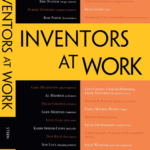Celebrating Heroes of Invention at the Temple of Innovation
May 5, 2011 | By Gene Quinn
Last night some thirty-nine extraordinary scientific trailblazers were inducted into the National Inventors Hall of Fame in the 39th Annual Induction Ceremony. Of the thirty-nine new inductees, twenty-nine were legacy inventors and ten were contemporary heroes of invention. The Master of Ceremonies was the award-winning NPR journalist and host of Talk of the Nation, Neal Conan. Throughout the evening Conan continued to refer to the host building for the ceremony as the “Temple of Innovation,” which is indeed an appropriate moniker. It was the old Patent Office building in Washington, DC, that hosted the 2011 National Inventors Hall of Fame Induction Ceremony.
Today the old Patent Office building is known as the Smithsonian American Art Museum, which houses the National Portrait Gallery. The building is one of Washington’s oldest public buildings and a National Historic Landmark. It originally was the home of the U.S. Patent Office starting in 1836, and while it functioned as the U.S. innovation agency some 1,891,197 patents were issued from this address.
It just felt so appropriate as the venue for the induction of 39 new members. This will also be the venue for the event for at least the next two years. With all due respect to the Smithsonian American Art Museum and the National Portrait Gallery, what this building should be is America’s Innovation Museum. It should house the National Inventors Hall of Fame and as many patent models and patented innovations as can fit within its walls. It should be the place that every school tour of DC stops at to educate our children about the importance of innovation, how important and influential the Patent Office once was (and should be today) and inspire them to greatness in the fields of math, science and engineering. Congress are you listening?
Sadly, for the most part Congress was not listening. Congressman Chaka Fattah, of Pennsylvania’s Second Congressional District, was present and introduced Pennsylvania inventors Joseph Woodland and Bernard Silver (inventors of the first optically scanned barcode). But other than Congressman Fattah there were to my knowledge no other members of Congress present and few, if any, Staffers from the Hill. It would have done Members of Congress good to see the stories of these extraordinary individuals who researched, developed, innovated and succeeded beyond the wildest dreams of what anyone could ever reasonably hope to accomplish. It is this innovation that has lead to life saving treatments, a better way of life, and countless American jobs. It was an inspiring, non-political evening that should have been celebrated at the highest levels in our government. This is who we want our children to become. These are the role models. We all need to work toward making math, science, engineering and innovation the sexy career path it should be. These thirty-nine inductees, and the other 421 previous inductees, together create perhaps the most exclusive society anywhere in the globe. They are no less than heroes of invention.
The event was awe inspiring really for a nerd like myself. I continually felt almost out of place as the truly extraordinary exploits of the men and women being inducted in the Hall of Fame were told in a classy, matter of fact but appropriately sentimental way. I had the privilege of having dinner at the table with the co-inventor of Prozac, Klaus Schmiegel, who was accompanied by his wife Joel. Schmiegel and co-inventor Bryan Molloy were inducted into the Hall of Fame in 1999, having invented a class of aryloxyphenylpropylamines which includes the compound fluoxetine hydrochloride, which is the active ingredient in Prozac®, the widely successful antidepressant. Schmiegel was cordial, gracious and extremely humble, as are all of the Hall of Fame inventors I met and know. Had you been at the table you would never have known you were siting next to a man whose innovation has meant so much to so many.
President John Kennedy once quipped at a ceremony for Nobel Prize winners at the White House that not since Thomas Jefferson dined alone had there been such brain power under that roof. With all due respect to Jefferson and that group of Nobel Prize winners, it is hard to imagine there being an assembly of more brain power than was in attendance at this, or any other, National Inventors Hall of Fame Induction Ceremony. By tradition many of the members of the Hall of Fame return every year to welcome the new class. In fact, late in the evening after the event Louis Foreman (Everyday Edison’s and Inventors Digest) joked with new Hall of Fame member Gary Michelson that now he would have to return next year and every other year for that matter. With one of the largest grins you could imagine Michelson responded that he couldn’t think of any better place to be and he would be more than happy to return.
Those like Michelson who are in the National Inventors Hall of Fame are to a person extraordinary individuals who in one way or another changed the course of history. The do not return to take a victory lap, nor to tell stories about how great their invention was, but rather they all seem to return to revel in the company of others they recognize as great.
The National Inventors Hall of Fame-ers I know typically are proud of their invention, a bit taken back by how so many folks marvel at what they created and keenly interested in learning more of the exploits of the others they themselves see as great inventors. These giants of the innovation industry are like so many other inventors. Their own invention was practically obvious to them and not much of a big deal. They seem genuinely and deeply touched by the impact their inventions have had and are simultaneously proud of what they have done and uncomfortable by the adulation.
I know Gary Michelson better than any of the other Hall of Fame inventors, having been introduced to him by Louis Foreman as someone I should talk with regard to patent reform. Since that first telephone call we have had occasion to speak several times, Michelson has written for IPWatchdog.com, gone on the record in a lengthy conversation and he has continued to try and provide the perspective of the independent inventor for Congress as they weigh various changes to the Patent Act.
Gary Michelson an independent inventor? That is almost incomprehensible, but true. What makes it nearly difficult for many to believe is the enormous success Michelson’s inventions have had in the marketplace. If you were to pick the top U.S. inventors based on market success Michelson would easily come in top ten, probably the top five. What might push Michelson up the ranks behind only the great Thomas Edison is that fact that of his over 260 U.S. patents and over 580 foreign patents, he is named as the sole inventor on the overwhelming majority. Michelson’s inventions, which relate to dramatic improvements to spinal surgery, are responsible for $5 billion in annual sales. He was inducted for his minimally invasive spinal surgery innovation, which turned at least some spinal surgeries into out-patient procedures where previously a minimum two-week hospital stay would be required.
In the video montage created to celebrate Michelson he explained that his grandmother suffered from a spinal ailment that caused her to lose feeling in her extremities. He retold a story about a time his grandmother was talking to him while she was leaning on the stove. Her hand caught fire and she didn’t realize at first because of the lack of sensation. He knew then he wanted to tackle the problem and ultimately went to medical school. He was told not to pursue spinal surgery or back surgery because patients simply never got any better. Michelson said: “I knew there had to be a better way.”
That theme of inspiration and tackling problems was retold over and over again through the evening, as was the story of the doubters. In the video montage put together to honor Whitfield Diffie, Martin Hellman and Ralph Merkle, all inducted for the invention of public key cryptography, Ralph Merkle explained that when getting his Ph.D. he handing in a paper and the response he received was that his thoughts were “muddled.” Merkle said he knew that meant he was on to something big and that it was, in fact, a good idea. The chamber erupted in laughter, undoubtedly because we all know that those creative minds that innovate truly paradigm shifting, disruptive technologies are told over and over again that their inventions won’t work.
The gift all of the truly extraordinary heroes of invention in the National Inventors Hall of Fame share is the ability to not be restricted by what is perceived to be scientific fact at any given time. If you stick around long enough scientific fact will change as those who are willing to question the orthodoxy discover and innovate in ways that fundamentally turn science on its head, thereby creating an entirely new set of truths. Of course, many of those truths and scientific facts will be questioned and challenged by future Hall of Famers who might only be in elementary school now, or perhaps not even born. But all of these folks are trailblazers with exceptionally inquisitive minds.
Perhaps the story of the night that best captured the spirit of challenging the established orthodoxy was the story of Steven Sasson, the inventor of the digital camera. As a young engineer working for Kodak, the 23 year old Sasson was tasked with project. He took it upon himself to make the project more grandiose and difficult, placing upon himself the goal of making a camera that could capture and display an electronic image. He only half-jokingly explained that in retrospect calling his creation “filmless photography” probably wasn’t the best choice he could have made given that the Kodak empire was created on film photography. Nevertheless, to the credit of Kodak they did not scuttle the innovation at all.
Sasson demonstrated the world’s first digitally captured image shown on a television screen, a .01 megapixel image. There were numerous questions his superiors had, not the least of which was why would anyone want to display a picture they took on a television. Of course, the rest is history. In 2008, over 24 million digital cameras were sold in the United States, generating $7 billion in revenue. Virtually all of today’s digital cameras still rely on the structure invented by Sasson in 1975.
Others inducted were Eric Fossum for the CMOS active pixel image sensor “camera on a chip,” George Devol who invented the first industrial robot, Esther Takeuchi for the lithium/silver vanadium oxide batter use in most of today’s implantable cardioverter defibrillators, and Joseph Woodland and Bernard Silver for the first optically scanned barcode. The legacy inductees are listed at the bottom of this article.
- Mary Anderson (1866-1953) — Windshield Wiper
- Stanley Macomber (1887-1967) — Open Web Joist
- Thomas Armat (1866-1948) — Motion Picture Projector
- Warren Marrison (1896-1980) — Quartz Clock
- Edwin Binney (1866-1934) — Carbon Black Manufacturing
- Thomas Murray (1860-1929) — Early Power Generation
- George A. Campbell (1870-1954) — Loading Coil
- Eadweard Muybridge (1830-1904) — Stop Action Photography
- Albert B. Dick (1870-1954) — Duplicating Equipment
- Walther H. Nernst (1864-1941) — Metallic Filament Incandescent Lamp
- Carleton Ellis (1876-1941) — Margarine
- Henry Phillips (1890-1958) — Phillips Screw
- Hannibal Goodwin (1822-1900) — Transparent Flexible Nitrocellulose Film
- Valdemar Poulsen (1869-1942) — Magnetic Wire Recorder
- John Hays Hammond, Jr. (1888-1965) — Radio Control
- Michael Pupin (1858-1935) — Loading Coil
- François Hennebique (1842-1921) — Reinforced Concrete Construction
- James Ritty (1836-1918) & John Ritty (ca. 1834-1913) — Cash Register
- Peter Cooper Hewitt (1861-1921) — Mercury-vapor Lamp
- Wallace C. Sabine (1868-1919) — Architectural Acoustics
- Frederick Ives (1856-1937) — Color Photography
- Eugene Sullivan (1872-1962) — Borosilicate Glass
- Charles F. Jenkins (1867-1934) — Motion Picture Projector
- Carl A. von Welsbach (1858-1929) — Improvements to Gas Lighting
- Clarence Kemp (unknown-1911) — Solar Water Heater
- Thomas A. Watson (1854-1934) — Improvements to Telephone
- Henry M. Leland (1843-1932) — Interchangeable Parts for Automobiles
- Rollin Henry White (1872-1962) — Flash Boiler for Generating Steam Controlled Differential Steering
References
- Celebrating Heroes of Invention at the Temple of Innovation [2011.05.05. Gene Quinn. IP Watchdog]
- Gary Michelson’s Letter to Congress Supporting Patent Reform [2011.02.25. Gary Michelson. IP Watchdog]
- Patent Legislation Reform The America Invents Act Of 2011 | Michelson Patents
- Awards, Honors & Engagements; Gary Karlin Michelson, M.D. | Michelson Medical Research Foundation [michelsonmedical.org]


![[Pg1] Innovation Lessons From a Billionaire | IP Watchdog](https://www.michelsonmedicalpatents.org/wp-content/uploads/2016/06-08-ipwatchdog-innovation-lessons-from-billionaire/Innovation-Lessons-From-a-Billionaire-IPWatchdog.com-_-Patents-Patent-Law_Page_1-260x185.jpg)
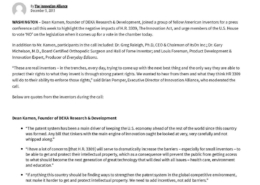
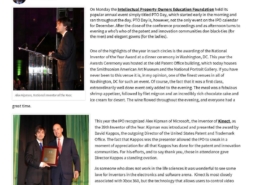 IP Watchdog
IP Watchdog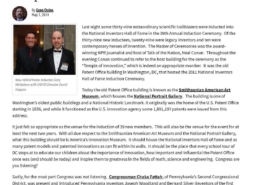 IP Watchdog
IP Watchdog![[Pg 1] A Conversation with Gary Michelson About Patent Reform | IPWatchdog.com](https://www.michelsonmedicalpatents.org/wp-content/uploads/2010/04-01-conversation-gary-michelson-patent-reform-ip-watchdog-gene-quinn/Pg-1-A-Conversation-with-Gary-Michelson-About-Patent-Reform-IPWatchdog.com-_-Patents-Patent-Law_IPWatchdog-260x185.jpg)
![[Pg1] National Inventors Hall of Fame 2011 Celebrating Heroes of Invention at the Temple of Innovation | National Hall of Fame (Credit: IP Watchdog} Dr. Gary K. Michelson was inducted into the National Inventors Hall of Fame in 2011. Photo by IP Watchdog.](https://www.michelsonmedicalpatents.org/wp-content/uploads/2011/05-05-celebrating-heroes-of-invention-at-the-temple-of-innovation-national-inventors-hall-of-fame-ip-watchdog-gene-quinn/pg1ip-watchdog.jpg)
![[Pg2] National Inventors Hall of Fame 2011 Celebrating Heroes of Invention at the Temple of Innovation | National Hall of Fame (Credit: IP Watchdog} [Pg2] National Inventors Hall of Fame 2011 Celebrating Heroes of Invention at the Temple of Innovation | National Hall of Fame (Credit: IP Watchdog}](https://www.michelsonmedicalpatents.org/wp-content/uploads/2011/05-05-celebrating-heroes-of-invention-at-the-temple-of-innovation-national-inventors-hall-of-fame-ip-watchdog-gene-quinn/pg2ip-watchdog.jpg)
![[Pg3] National Inventors Hall of Fame 2011 Celebrating Heroes of Invention at the Temple of Innovation | National Hall of Fame (Credit: IP Watchdog} [Pg3] National Inventors Hall of Fame 2011 Celebrating Heroes of Invention at the Temple of Innovation | National Hall of Fame (Credit: IP Watchdog}](https://www.michelsonmedicalpatents.org/wp-content/uploads/2011/05-05-celebrating-heroes-of-invention-at-the-temple-of-innovation-national-inventors-hall-of-fame-ip-watchdog-gene-quinn/pg3ip-watchdog.jpg)
![[Pg4] National Inventors Hall of Fame 2011 Celebrating Heroes of Invention at the Temple of Innovation | National Hall of Fame (Credit: IP Watchdog} An IPWatchdog list of some famous inventors from generations past, showing when they lived and what they are famous for inventing.](https://www.michelsonmedicalpatents.org/wp-content/uploads/2011/05-05-celebrating-heroes-of-invention-at-the-temple-of-innovation-national-inventors-hall-of-fame-ip-watchdog-gene-quinn/pg4ip-watchdog.jpg)
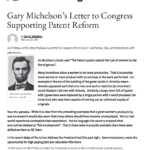 IP Watchdog
IP Watchdog